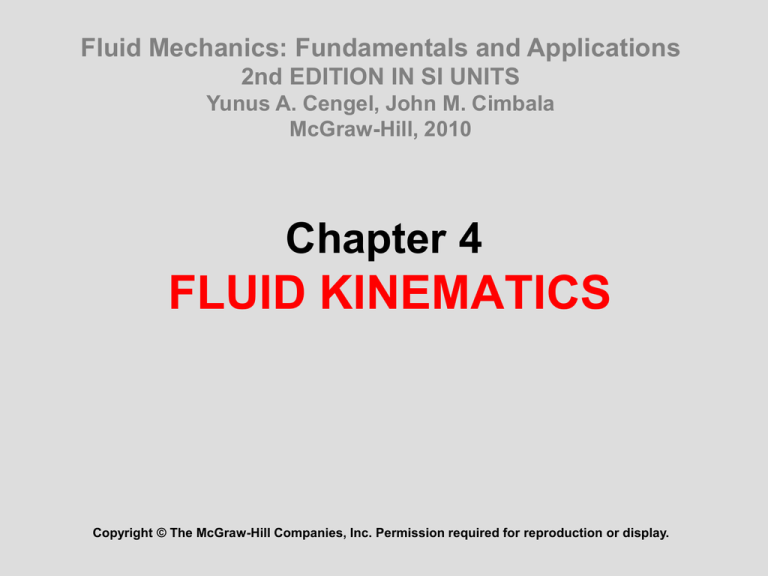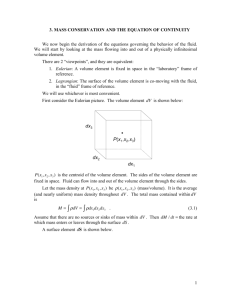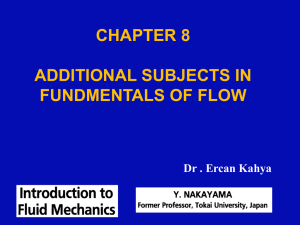Chapter 1 INTRODUCTION AND BASIC CONCEPTS
advertisement

Fluid Mechanics: Fundamentals and Applications 2nd EDITION IN SI UNITS Yunus A. Cengel, John M. Cimbala McGraw-Hill, 2010 Chapter 4 FLUID KINEMATICS Copyright © The McGraw-Hill Companies, Inc. Permission required for reproduction or display. Objectives • Understand the role of the material derivative in transforming between Lagrangian and Eulerian descriptions • Distinguish between various types of flow visualizations and methods of plotting the characteristics of a fluid flow • Appreciate the many ways that fluids move and deform • Distinguish between rotational and irrotational regions of flow based on the flow property vorticity • Understand the usefulness of the Reynolds transport theorem 2 4–1 ■ LAGRANGIAN AND EULERIAN DESCRIPTIONS Kinematics: The study of motion. Fluid kinematics: The study of how fluids flow and how to describe fluid motion. There are two distinct ways to describe motion: Lagrangian and Eulerian Lagrangian description: To follow the path of individual objects. This method requires us to track the position and velocity of each individual fluid parcel (fluid particle) and take to be a parcel of fixed identity. With a small number of objects, such as billiard balls on a pool table, individual objects can be tracked. In the Lagrangian description, one must keep track of the position and velocity of individual particles. 3 • • • • • A more common method is Eulerian description of fluid motion. In the Eulerian description of fluid flow, a finite volume called a flow domain or control volume is defined, through which fluid flows in and out. Instead of tracking individual fluid particles, we define field variables, functions of space and time, within the control volume. The field variable at a particular location at a particular time is the value of the variable for whichever fluid particle happens to occupy that location at that time. For example, the pressure field is a scalar field variable. We define the velocity field as a vector field variable. Collectively, these (and other) field variables define the flow field. The velocity field can be expanded in Cartesian coordinates as 4 • In the Eulerian description we don’t really care what happens to individual fluid particles; rather we are concerned with the pressure, velocity, acceleration, etc., of whichever fluid particle happens to be at the location of interest at the time of interest. In the Eulerian description, one defines field variables, such as the pressure field and the velocity field, at any location and instant in time. • While there are many occasions in which the Lagrangian description is useful, the Eulerian description is often more convenient for fluid mechanics applications. 5 6 7 A Steady Two-Dimensional Velocity Field Velocity vectors for the velocity field of Example 4–1. The scale is shown by the top arrow, and the solid black curves represent the approximate shapes of some streamlines, based on the calculated velocity vectors. The stagnation point is indicated by the circle. The shaded region represents a portion of the flow field that can approximate flow into an inlet. 8 Acceleration Field The equations of motion for fluid flow (such as Newton’s second law) are written for a fluid particle, which we also call a material particle. If we were to follow a particular fluid particle as it moves around in the flow, we would be employing the Lagrangian description, and the equations of motion would be directly applicable. Newton’s second law applied to a fluid For example, we would define the particle; the acceleration vector (gray arrow) particle’s location in space in terms is in the same direction as the force vector of a material position vector (black arrow), but the velocity vector (red (xparticle(t), yparticle(t), zparticle(t)). arrow) may act in a different direction. e.g: 9 Velocity field Given: Therefore, HOW? Local acceleration (nonzero for unsteady state, zero for steady state) Advective (convective) acceleration (nonzero for steady and unsteady state 10 The components of the acceleration vector in cartesian coordinates: Local acceleration Figure 4.8 Advective acceleration Flow of water through the nozzle of a garden hose illustrates that fluid particles may accelerate, even in a steady flow. In this example, the exit speed of the water is much higher than the water speed in the hose, implying that fluid particles have accelerated 11 even though the flow is steady. 12 13 14 Material Derivative The total derivative operator d/dt in this equation is given a special name, the material derivative; it is assigned a special notation, D/Dt, in order to emphasize that it is formed by following a fluid particle as it moves through the flow field. Other names for the material derivative include total, particle, Lagrangian, Eulerian, and substantial derivative. The material derivative D/Dt is defined by following a fluid particle as it moves throughout the flow field. In this illustration, the fluid particle is accelerating to the right as it moves up and to the right. 15 The material derivative D/Dt is composed of a local or unsteady part and a convective or advective part. 16 Note: From Example 4.1 17 x 18 Homework • Please read and understand about: • Flow Patterns and Flow Visualization Streamlines and Streamtubes, Pathlines, Streaklines, Timelines Refractive Flow Visualization Techniques Surface Flow Visualization Techniques • Plots of Fluid Flow Data Profile Plots, Vector Plots, Contour Plots …………………..to do assignment 19 4–5 ■ VORTICITY AND ROTATIONALITY Another kinematic property of great importance to the analysis of fluid flows is the vorticity vector, defined mathematically as the curl of the velocity vector Vorticity is equal to twice the angular velocity of a fluid particle The direction of a vector cross product is determined by the righthand rule. The vorticity vector is equal to twice the angular velocity vector 20 of a rotating fluid particle. • If the vorticity at a point in a flow field is nonzero, the fluid particle that happens to occupy that point in space is rotating; the flow in that region is called rotational (ζ ≠ 0 ; rotational). • Likewise, if the vorticity in a region of the flow is zero (or negligibly small), fluid particles there are not rotating; the flow in that region is called irrotational. (ζ = 0 ; irrotational). • Physically, fluid particles in a rotational region of flow rotate end over end as they move along in the flow. The difference between rotational and irrotational flow: fluid elements in a rotational region of the flow rotate, but those in an irrotational region of the flow do not. 21 For a two-dimensional flow in the xy-plane, the vorticity vector always points in the z-direction or −z-direction. In this illustration, the flag-shaped fluid particle rotates in the counterclockwise direction as it moves in the xy-plane; its vorticity points in the positive z-direction as shown. 22 For a two-dimensional flow in the rplane, the vorticity vector always points in the z (or -z) direction. In this illustration, the flag-shaped fluid particle rotates in the clockwise direction as it moves in the rθ-plane; its vorticity points in the -z-direction as shown. Note: rotate clockwise = vorticity points in -z direction. counterclockwise = z direction 23 Comparison of Two Circular Flows Not all flows with circular streamlines are rotational Streamlines and velocity profiles for (a) flow A, solid-body rotation and (b) flow B, a line vortex. Flow A is rotational, but flow B is irrotational everywhere except at the origin. 24 A simple analogy can be made between flow A and a merry-goround or roundabout, and flow B and a Ferris wheel. As children revolve around a roundabout, they also rotate at the same angular velocity as that of the ride itself. This is analogous to a rotational flow. In contrast, children on a Ferris wheel always remain oriented in an upright position as they trace out their circular path. This is analogous to an irrotational flow. A simple analogy: (a) rotational circular flow is analogous to a roundabout, while (b) irrotational circular flow is analogous to a Ferris wheel. 25 4–6 ■ THE REYNOLDS TRANSPORT THEOREM Two methods of analyzing the spraying of deodorant from a spray can: (a) We follow the fluid as it moves and deforms. This is the system approach—no mass crosses the boundary, and the total mass of the system remains fixed. (b) We consider a fixed interior volume of the can. This is the control volume approach— mass crosses the boundary. The relationship between the time rates of change of an extensive property for a system and for a control volume is expressed by the Reynolds transport theorem (RTT). The Reynolds transport theorem (RTT) provides a link between the system approach and the control volume approach. 26 The time rate of change of the property B of the system is equal to the time rate of change of B of the control volume plus the net flux of B out of the control volume by mass crossing the control surface. This equation applies at any instant in time, where it is assumed that the system and the control volume occupy the same space at that particular instant in time. A moving system (hatched region) and a fixed control volume (shaded region) in a diverging portion of a flow field at times t and t+t. The upper and lower bounds are streamlines of the flow. 27 28 29 Reynolds transport theorem applied to a control volume moving at constant velocity. Relative velocity crossing a control surface is found by vector addition of the absolute velocity of the fluid and the negative of the local velocity of the control surface. 30 An example control volume in which there is one well-defined inlet (1) and two well-defined outlets (2 and 3). In such cases, the control surface integral in the RTT can be more conveniently written in terms of the average values of fluid properties crossing each inlet and outlet. 31 Alternate Derivation of the Reynolds Transport Theorem A more elegant mathematical derivation of the Reynolds transport theorem is possible through use of the Leibniz theorem The Leibniz theorem takes into account the change of limits a(t) and b(t) with respect to time, as well as the unsteady changes of integrand G(x, t) with time. 32 33 34 The equation above is valid for arbitrarily shaped, moving and/or deforming CV at time t. The material volume (system) and control volume occupy the same space at time t (the blue shaded area), but move and deform differently. At a later time they are not coincident. 35 36 Relationship between Material Derivative and RTT While the Reynolds transport theorem deals with finite-size control volumes and the material derivative deals with infinitesimal fluid particles, the same fundamental physical interpretation applies to both. The Reynolds transport theorem for finite volumes (integral analysis) is analogous to the material derivative for infinitesimal volumes (differential analysis). In both cases, we transform from a Lagrangian or system viewpoint to an Eulerian or control volume viewpoint. Just as the material derivative can be applied to any fluid property, scalar or vector, the Reynolds transport theorem can be applied to any scalar or vector property as well. 37






